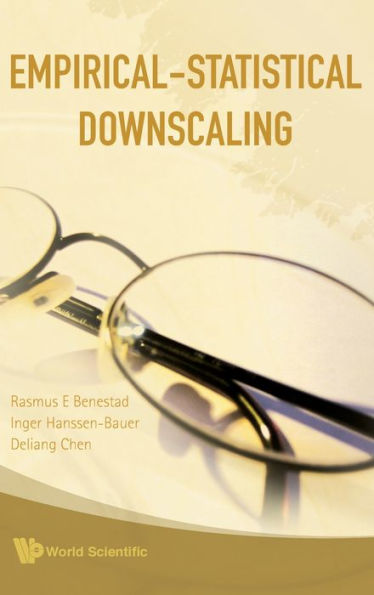Table of Contents
Preface v
1 Introduction 1
1.1 History 1
1.2 The Lay-Out 3
1.3 Concepts and Definitions 3
1.3.1 The problem: What is downscaling and why downscaling 3
1.3.1.1 What is downscaling? 3
1.3.1.2 Why downscaling? 8
1.3.2 Notations 10
1.3.3 Definitions 12
1.3.4 Anomalies in ESD 18
1.4 Further Reading 19
1.5 Examples 19
1.6 Exercises 20
2 Downscaling Strategies 22
2.1 Different Approaches 22
2.1.1 Dynamical downscaling 22
2.2 Philosophy Behind ESD 24
2.2.1 Considerations 26
2.2.2 A physics-inspired view 32
2.2.3 A purely statistical view 34
2.3 What is "Skillful Scale"? 34
2.4 Further Reading 39
2.4.1 Dynamical versus empirical-statistical downscaling 39
2.5 Examples 41
2.5.1 Geostrophic balance 41
2.5.2 Basic preprocessing 41
2.6 Exercises 44
3 Predictors and Preprocessing 45
3.1 Choosing Predictors 45
3.2 Circulation Indices 46
3.2.1 Stationarity 48
3.2.2 The North Atlantic Oscillation (NAO) 49
3.2.3 Autocorrelation and degrees of freedom 49
3.2.4 Empirical orthogonal functions 50
3.2.5 Varieties of EOF analysis 57
3.2.5.1 Rotated EOFs 57
3.2.6 Complex and frequency-domain EOFs 58
3.2.6.1 Complex EOFs 58
3.2.6.2 Frequency-domain EOFs 59
3.2.6.3 Extended EOFs 59
3.2.6.4 Mixed-field and common EOFs 59
3.2.7 EOF in ESD 60
3.3 Further Reading 61
3.4 Examples 62
3.4.1 Basic EOF analysis 62
3.4.2 Mixed-field EOFs 62
3.4.3 Extended EOFs 63
3.5 Exercises 64
4 Linear Techniques 67
4.1 Introduction 67
4.2 Linear Multivariate Methods 69
4.3 Regression 70
4.3.1 Multivariate regression models 71
4.4 Canonical Correlation Analysis 73
4.4.1 Classical CCA 73
4.4.1.1 Linear relationships from themodel based on CCA 75
4.5 Singular Vectors 76
4.6 Further Reading 78
4.7 Examples 78
4.7.1 CCA 80
4.8 Exercises 84
5 Nonlinear Techniques 85
5.1 Introduction 85
5.2 The Analog Model 85
5.2.1 Caveats 86
5.3 Classification Methods 90
5.3.1 Cluster analysis 91
5.4 Neural Nets 93
5.5 Further Reading 93
5.6 Examples 96
5.6.1 Analog model (Fig. 5.8) 96
5.6.2 Clustering 97
5.7 Exercises 97
6 Predictions and Diagnostics 98
6.1 Common Notations and Definitions 98
6.2 Predictions 99
6.3 Trends 100
6.3.1 Test for trends 101
6.3.1.1 Trend-testing based on Spearman rank coefficient 101
6.3.1.2 Mann-Kendall rank correlation statistics 101
6.3.1.3 Trend testing based on student's t-test 102
6.4 Diagnostics 102
6.5 Statistical Inference 103
6.5.1 Confidence intervals for rejection 103
6.5.2 Student's t-test 104
6.5.3 F-statistics 104
6.6 Quality Control 105
6.7 Model Skill 108
6.8 Evaluation Techniques 108
6.8.1 Anomalous correlation 109
6.8.2 The R[superscript 2] score 109
6.8.3 Root-mean-square-error 110
6.8.4 Representative statistical distributions 111
6.9 Cross-Validation 111
6.10 Further Reading 113
6.11 Examples (Fig. 6.7) 113
6.11.1 Illustration of cross-validation 113
6.11.2 Using ESD to validate cyclone counts 114
6.11.3 ESD to reconstruct historical climate records 116
6.11.4 The objDS-function 116
6.11.5 Prediction pattern 118
6.11.6 Simple trend-fit 120
6.11.7 Scatter plot and correlation 120
6.12 Exercises 120
7 Shortcomings and Limitations 122
7.1 Level of Variability 124
7.2 Model Stationarity 125
7.2.1 "Perfect model" simulation 126
7.2.2 "Historical" simulation 126
7.2.3 Minimizing risk of nonstationarity 127
7.2.4 Consistency 128
7.2.5 Take-home messages 130
7.3 Examples 131
7.4 Exercises 133
8 Reducing Uncertainties 134
8.1 Cascading Uncertainties 134
8.2 De-Trending in the Calibration 136
8.3 Using Different Predictands 138
8.4 Optimal Number of Predictors 138
8.5 Trends versus Time Slices 139
8.6 Domain Choices 141
8.7 Spatial Coherence 142
8.8 Projection of EOFs 144
8.9 The Common EOF Frame 144
8.9.1 Adjustment and bias corrections 146
8.10 Further Reading 146
8.11 The Example Illustrating Huth's Paradox 148
8.12 Exercises 148
9 Downscaling Extremes and PDFs 149
9.1 Outliers and Extremes 149
9.2 Robustness and Resistance 150
9.2.1 Estimators 151
9.3 Probability Density Functions 151
9.3.1 What is probability distribution and why use it? 151
9.3.2 Normal/Gaussian distribution 152
9.3.3 The exponential distribution 153
9.3.4 Gamma distribution 154
9.4 Extreme Values 156
9.4.1 iid-test 158
9.5 Downscaling Extreme Indices 160
9.5.1 Generalized linear models 160
9.5.1.1 Maximum likelihood estimation 161
9.6 Downscaling PDFs 162
9.6.1 Downscaling PDFs for temperature 163
9.6.2 Downscaling PDFs for daily precipitation 163
9.7 Further Reading 168
9.8 Examples 169
9.8.1 iid-test 169
9.8.2 Downscaling PDFs for normal distribution 169
9.8.3 Downscaling PDFs exponential distribution 170
9.9 Exercises 172
10 Weather Generator 173
10.1 Weather Generator 174
10.2 Richardson Type WG for Precipitation 175
10.3 Downscaling Based on WG 176
10.4 Examples 177
10.4.1 Coin-flipping 177
10.5 Exercises 177
11 Implementing ESD 179
11.1 Numerical Tools 179
11.1.1 R 179
11.1.1.1 clim.pact 179
11.1.1.2 Rclim 181
11.1.2 SDSM 181
11.1.3 ClimateExplorer 181
11.1.4 ENSEMBLE-S2D 181
11.2 Gridding the Results 182
11.2.1 Kriging 182
11.2.2 Residual kriging 182
11.2.3 GIS-packages 186
Acknowledgments 188
Appendix 189
References 201
Index 213



